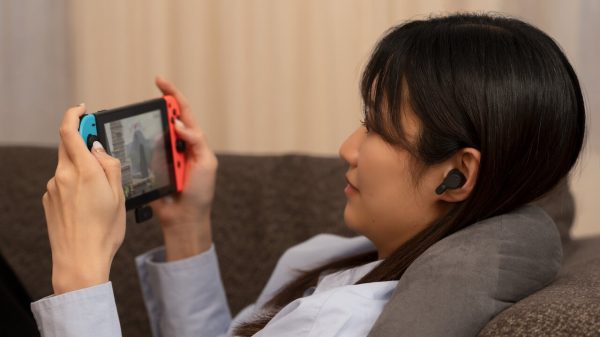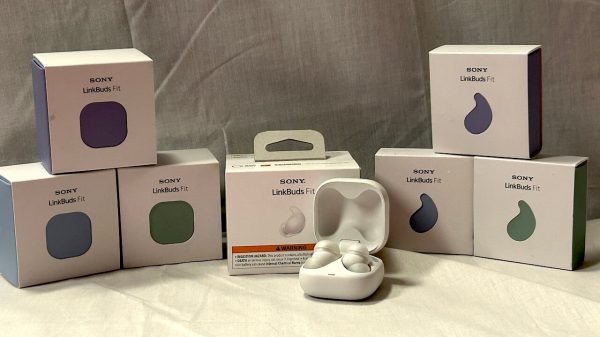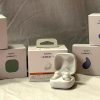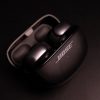It seems today that everyone is jumping into the TWS market. We’ve seen all of the major players introduce new models, dozens of start-ups enter the market, and companies that have previously focused on other audio gear take the plunge. One of the last to enter has been Bowers & Wilkins. Those familiar with the venerable high-end brand are well acquainted with their long history of premium speakers like the Nautilus and their participation in the automotive space with brands like BMW, Maserati, Volvo, and McLaren. The Bowers & Wilkins PI7 Wireless Earphones arrive with high expectations.

B&W are not newcomers to the headphone space; the brand has offered premium headphones for a number of years. I have owned and enjoyed the B&W P5 and P7 models which were on-ear headphones with a very distinct IEM type of voicing.
I’ve also owned the P7 wireless headphones which were quite good during its lifespan but which has already been surpassed by the new B&W PX7 with a restyled cup, improved battery life and connectivity. I’ve been able to briefly audition the newer PX7 and its sonics were quite similar to the older P7 which were my favorite headphones to fly and travel with.
IEMs are a more recent development for B&W with four models in their current catalog. The PI3 and PI4 are both headband models while the PI5 and PI7 are the true wireless models in the line-up.
Prices overlap with the PI4 being offered at $299 while the PI5 costs $249 so don’t think of the sequence numbers as price or quality indicators as that may result in some confusion; Instead, the PI3 and PI4 represent one line while the PI5 and PI7 are a second.
I was asked to review the flagship PI7 which retail for $399.99 USD. This puts them squarely in the crosshairs of wireless earphones like the Sony WF-1000XM4 and Master & Dynamic MW08 at $299 retail and models like the Beyerdynamic Xelento and Audeze LCDi3 in the price bracket above the PI7.
I had a hard time finding anything else at the exact price point as the Bowers & Wilkins PI7 Wireless Earphones to compare against which may be exactly what B&W intended.
What’s in the Box?

Most of the technical specifications are on the last page of the manual that can be downloaded from B&W’s site if desired before purchase. Removing the slipcover and lifting the top reveals the case with the rest of the accessories hidden under the plastic tray the case rides in. The kit comes with case, earbuds, three sets of tips, a charging cable, and a USB Type-C to 3.5mm cable along with the manuals and warranty card.
The kit is pretty much standard except for the USB to 3.5 cable that is the first hint that there is something very different about these wireless earphones.

The earpieces use an oval-shaped polymer inner shell with the nozzles exiting the leading end with a distinct upward rake. Immediately behind the nozzle is a small circular vent followed by the L/R indicator and a series of three contact points for charging.
Two additional magnetic contact points sit at the mid-point of the under surface at the top and bottom of the inner shell. The sides of the inner shell have two larger vents with metal grates over them, one at the bottom front is about 4mm in length while the other runs most of the top surface.

On the outer side, a large round metal control button takes up the forward two thirds of the inner shell leaving the rear third exposed. Curiously, the buttons on the outer surface are devoid of any identifying logo or label with Bowers and Wilkins printed on the lower surface. When seated in your ear, no identifying information is visible.
Inside Your Ear
For me, the best fit was with the medium tips and I had no trouble wearing the PI7 for the full battery drain which wasn’t the longest of the true wireless earphones that I’ve tried so far this year.
Inside the shell, the PI7 has the requisite Bluetooth chip that provides aptX HD, aptX adaptive, AAC and SBC connectivity. I found connectivity to work well as long as the source device was within 15 meters or so and even a single interior wall didn’t usually defeat the signal.
The PI7’s electronics also handle noise cancelling using six internal microphones, and an ambient mode to allow the user to hear outside noise if desired.
The PI7 uses a 9.2mm dynamic driver to handle low end information and the critical midrange, while a balanced armature driver is used for handling the treble which is fairly standard. Most of the time with these types of wireless earphones, we see a single amplifier used and then a crossover splits the signal into the appropriate frequency range for each driver. With the PI7, we see a crossover first, two amplifiers, and then the drivers.
B&W claims better detail, less distortion, and better realism as a result of this design topology.
The downside to all that technology in the battery life is only four hours per charge on the earpieces and four (4) charges to the case before needing a three (3) hour recharge time plugged into a USB-C charger.

The LED indicator on the case indicates the charging status of both the case and earpieces, but it uses a single LED of varying color to display both the earpiece status and the case state so it is far easier to use the B&W control app to keep a closer tab on this information.
In addition to the normal charging functions, the case operates as a Bluetooth transmitter to allow connecting your PI7 to non-Bluetooth enabled devices via the USB-C to 3.5mm cable. Not only does this allow anything with a headphone jack to work with the PI7, but it also allows for a secondary connection so two B&W headphones or earphones can be connected to the same source for sharing music.
I found this feature to work quite well and was able to use several older DAPs and an early generation iPad and still take advantage of aptX by using the case as the transmitter rather than relying on the source to provide that functionality. Be careful doing this around the pool though as while the earpieces are IPX rated, the case is definitely not waterproof.
Sound Quality
Sonically, the Bowers & Wilkins PI7 wireless earphones deliver the performance quality I expected from them.
Starting off with the Cowboy Junkies’ Trinity Sessions, the PI7 exhibited an above average soundstage and degree of separation between the musicians. Many headphones and loudspeakers struggle to give the cathedral its proper sense of space, but the PI7 did a very commendable job delivering the depth and the very audible echo that comes from far back in the recording. The venue in Toronto added its own very distinct sonic signature to the entire album and it’s very present through these earphones.

The other feature of the PI7 that one immediately notices is the layering and detail which are better than most of the other wireless earphones in the category. All of the nuance in Margo Timmins’ voice was beautifully rendered by the PI7 earphones and it made no attempt to hold anything back.
Moving on to Vintage Trouble’s “Run like the River,” I discovered another aspect of the PI7’s sound; bass becomes the star of the show. The PI7 has an elevated sub-bass that can overshadow the midrange a bit and while the speed of the driver is fairly quick, there is some thickening as tracks get busier.
Taylor’s voice cuts through the mix well, but Nalle’s guitar is a little recessed and I’d like to see it step forward more. Switching to Edvard Grieg’s “In the Hall of the Mountain King,” the midrange is slightly recessed behind the sub-bass which again is a dominant feature of the landscape.
The treble is also elevated but not quite as much as the sub-bass which keeps the PI7 from become fatiguing. I’d like to see an eq added to the B&W app so more tuning can be done as the soundscapes feature that allows for playing bubbling brooks or campfire crackles is just not as big a feature to me as a good 10 band equalizer would be.
I’d settle for a 5 band either but more is better here.
Noise cancelling is fairly basic and does a good job cutting out the white noise generators at the office but struggles with wind and vocals to some extent and quick loud noises like a car horn nearly always defeated the noise cancelling.


The ambient feature is nice and allows a greater degree of control as it allows the user to adjust the amount of sound to let through while the noise cancelling offers an auto adjust or a fixed setting but no user selectable options.
Conclusion
Overall, the Bowers & Wilkins PI7 wireless earphones accomplish a lot of what it sets out to do. It is comfortable for extended wear, has good detail and a large soundstage which are tough to do in a closed in-ear, and the transmitter case is a novel option.
It comes back down to earth a bit on its middle of the pack battery life and average noise cancelling. The battery life is probably a permanent limit, but the lack of eq and shortcomings of the noise cancelling may be addressable by firmware update.

The app tells me I have the latest firmware for both case and earpieces so maybe when a new version comes out I’ll have an update. Is it worth a try? Minus the shortcomings that I mentioned, it is one of the best sounding in the category. Those who want a big bass kick for rock and pop music will appreciate the tuning and the lifelike soundstage which are quite rare in true wireless earphones. The Bowers & Wilkins PI7 wireless earphones are well worth the asking price and a solid piece of kit.
For more information: Bowers & Wilkins PI7
Where to buy: $399 at Amazon (black) | Crutchfield (white)




































